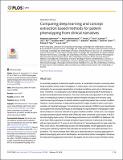Comparing deep learning and concept extraction based methods for patient phenotyping from clinical narratives
Author(s)
Gehrmann, Sebastian; Li, Yeran; Carlson, Eric T.; Wu, Joy T.; Welt, Jonathan; Foote, John; Moseley, Edward T.; Grant, David W.; Tyler, Patrick D.; Dernoncourt, Franck; Celi, Leo Anthony G.; ... Show more Show less
Downloadjournal.pone.0192360.pdf (2.149Mb)
PUBLISHER_CC
Publisher with Creative Commons License
Creative Commons Attribution
Terms of use
Metadata
Show full item recordAbstract
This is an open access article distributed under the terms of the Creative Commons Attribution License, which permits unrestricted use, distribution, and reproduction in any medium, provided the original author and source are credited. In secondary analysis of electronic health records, a crucial task consists in correctly identifying the patient cohort under investigation. In many cases, the most valuable and relevant information for an accurate classification of medical conditions exist only in clinical narratives. Therefore, it is necessary to use natural language processing (NLP) techniques to extract and evaluate these narratives. The most commonly used approach to this problem relies on extracting a number of clinician-defined medical concepts from text and using machine learning techniques to identify whether a particular patient has a certain condition. However, recent advances in deep learning and NLP enable models to learn a rich representation of (medical) language. Convolutional neural networks (CNN) for text classification can augment the existing techniques by leveraging the representation of language to learn which phrases in a text are relevant for a given medical condition. In this work, we compare concept extraction based methods with CNNs and other commonly used models in NLP in ten phenotyping tasks using 1,610 discharge summaries from the MIMIC-III database. We show that CNNs outperform concept extraction based methods in almost all of the tasks, with an improvement in F1-score of up to 26 and up to 7 percentage points in area under the ROC curve (AUC). We additionally assess the interpretability of both approaches by presenting and evaluating methods that calculate and extract the most salient phrases for a prediction. The results indicate that CNNs are a valid alternative to existing approaches in patient phenotyping and cohort identification, and should be further investigated. Moreover, the deep learning approach presented in this paper can be used to assist clinicians during chart review or support the extraction of billing codes from text by identifying and highlighting relevant phrases for various medical conditions.
Date issued
2018-02Department
Massachusetts Institute of Technology. Institute for Medical Engineering & Science; Massachusetts Institute of Technology. Department of Electrical Engineering and Computer Science; MIT Critical Data (Laboratory)Journal
PLOS ONE
Publisher
Public Library of Science
Citation
Gehrmann, Sebastian et al. “Comparing Deep Learning and Concept Extraction Based Methods for Patient Phenotyping from Clinical Narratives.” Edited by Jen-Hsiang Chuang. PLOS ONE 13, 2 (February 2018): e0192360 © 2018 Gehrmann et al
Version: Final published version
ISSN
1932-6203